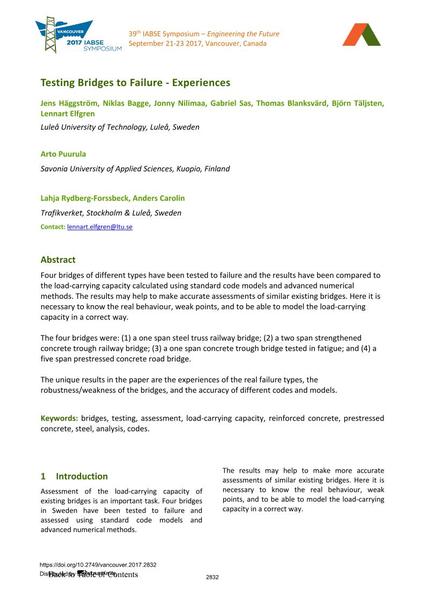Testing Bridges to Failure - Experiences

|
|
|||||||||||
Détails bibliographiques
| Auteur(s): |
Jens Häggström
(Luleå University of Technology, Luleå, Sweden)
Niklas Bagge Jonny Nilimaa (Luleå University of Technology, Luleå, Sweden) Gabriel Sas (Luleå University of Technology, Luleå, Sweden) Thomas Blanksvärd (Luleå University of Technology, Luleå, Sweden) Björn Täljsten (Luleå University of Technology, Luleå, Sweden) Lennart Elfgren Arto Puurula (Savonia University of Applied Sciences, Kuopio, Finland) Lahja Rydberg- Forssbeck Anders Carolin (Abstract) |
||||
|---|---|---|---|---|---|
| Médium: | papier de conférence | ||||
| Langue(s): | anglais | ||||
| Conférence: | IABSE Symposium: Engineering the Future, Vancouver, Canada, 21-23 September 2017 | ||||
| Publié dans: | IABSE Symposium Vancouver 2017 | ||||
|
|||||
| Page(s): | 2832-2839 | ||||
| Nombre total de pages (du PDF): | 8 | ||||
| Année: | 2017 | ||||
| DOI: | 10.2749/vancouver.2017.2832 | ||||
| Abstrait: |
Four bridges of different types have been tested to failure and the results have been compared to the load-carrying capacity calculated using standard code models and advanced numerical methods. The results may help to make accurate assessments of similar existing bridges. Here it is necessary to know the real behaviour, weak points, and to be able to model the load-carrying capacity in a correct way. The four bridges were: (1) a one span steel truss railway bridge; (2) a two span strengthened concrete trough railway bridge; (3) a one span concrete trough bridge tested in fatigue; and (4) a five span prestressed concrete road bridge. The unique results in the paper are the experiences of the real failure types, the robustness/weakness of the bridges, and the accuracy of different codes and models. |
||||
| Mots-clé: |
acier ponts
|
||||
